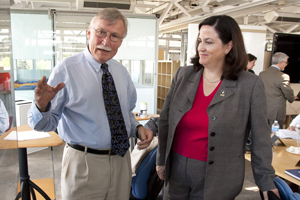Army Enlists CMU's Help To Save Energy
By Heidi Opdyke
 Even the U.S. Army wants to shrink its carbon "bootprint."
Even the U.S. Army wants to shrink its carbon "bootprint."
Large U.S. Army bases have all the intricacies of a small city and all the energy challenges as well. Thousands of people work and live in them, and each base has its own challenges handling energy consumption, water use and waste management.
When it comes to energy costs, the Army is grappling with how to continue to support national security and stay nimble at a time when energy costs are rising and budgets are being reduced.
Overseas, energy and water supplies can face significant threats; therefore, addressing energy security and sustainability are essential to the Army's mission.
"We can't do our mission unless we can operate our facilities economically," said The Honorable Katherine Hammack, assistant secretary of the Army for Installations, Energy, and Environment, during a visit to CMU's Center for Building Performance and Diagnostics (CBPD). Hammack met with CMU thought-leaders engaged by Volker Hartkopf, director of the CBPD.
Hammack focuses on supporting an Army of innovative thinkers to inspire the facilities' performance, so she came to CMU to look for ways to improve energy and the environmentally effectiveness of Army installations.
Faculty from architecture, engineering, economics and social science, and advancing energy and environmentally effective systems and technologies for best building, community and urban practices participated.
"Many of us practice what we preach and are well-focused on the opportunities to integrate net zero energy, net zero water and waste goals, objectives and practices in holistic regional, urban, neighborhood and building contexts," Hartkopf said.
Additional discussion partners included professionals from major companies such as Affiliated Engineers, Bayer, Chatham University, City of Pittsburgh, Environmental Protection Agency, Government Services Administration, Heinz Endowments, Measuring and Monitoring Services, OSIsoft, PEPCO Energy Services, PPG, Robert Bosch R&D Technology Center, Sasaki Associates, Thar Process, University Energy Partnership, U.S. Army and U.S. Army Corps of Engineers.
"To achieve net zero it requires all of the fields," said James Halpern (A '81), president of Measuring and Monitoring Services, during a presentation on the opportunities for strategic cooperation to meet the goals and objectives of the Army. "This is a place where you can get stuff that works. CMU is trying to fundamentally change things to make them better."
Repurposing, recycling and recovering energy are essential to the military's mission, Hammack said. She emphasized the major challenges and opportunities to create Army bases to serve as examples for building the best performing cities of the future. To meet these challenges, the Army has a pilot program for 16 installations to be net zero energy, water and waste by 2020.
"We are creating a culture that recognizes the value of sustainability measured not just in terms of financial benefits, but benefits to maintaining mission capability, quality of life, relationships with local communities, and the preservation of options for the Army's future," Hammack said.
Hartkopf said that the participants are now discussing how they can strategically cooperate with the Army on meeting its net zero challenges.
Professor Volker Hartkopf takes Katherine Hammack, Assistant Secretary of the Army for Installations Energy, and Environment, on a tour of the Robert L. Preger Intelligent Workplace, which is a living laboratory in sustainability for workers and organizations.
